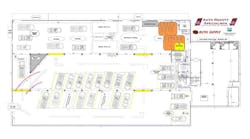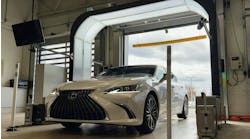More
than just a bag of hot air?Air bags. What can you say? They've been
praised and ridiculed, saved lives and cost lives, been promoted and
protested, caused lawsuits because vehicles had them and caused them
because they didn't have them-and on and on.As a collision repair technician, how does
all this affect you? Well…it doesn't. Regardless of everything else, you
still have to work on and around the things day in and day out. So what's
best for you to do? Learn what you are and aren't supposed to do and find
out how to work safely around them.In the collision repair industry, air bags
come in two basic varieties: those that are already deployed and wrapped
in wrinkled sheet metal and those that aren't deployed. We'll cover the
things techs need to know about each kind a little later, but first, here
are a few words about how air bags work.Air Bags at WorkThe majority of air bag systems have at
least two deceleration sensors, one or two air bags, a wiring coil for the
driver's side, some shorting bars and an electronic module.When the sensors detect a predetermined
rate of deceleration-usually from hitting another vehicle-one of the
sensors applies a voltage to the air bag and the other supplies a ground. This closed circuit sends current through a heating element,
which ignites a substance called sodium azide. This burns very quickly and
produces a large amount of nitrogen gas that inflates the air bag. This
happens in twenty-thousandths of a second. Immediately after the air bag
deploys, all of the nitrogen escapes through holes in the back of the bag
and allows it to deflate.Now, a word about sodium azide, which is
the same substance used in the solid rocket boosters for the space
shuttle. In essence, it is rocket fuel. That may be a little unnerving to
some people, but it is necessary to use that sort of substance to make the
system operate fast enough. (We'll address some frequently asked questions
about this substance a little later.) There are alternative systems, some
using pressurized gas, that may eventually replace sodium azide. But
working around the substance poses no risk to repair technicians who apply
proper safety precautions.Another characteristic of air bag systems
that technicians need to be aware of involves the control modules. In an accident, the voltage side sensor and the ground
side sensors could close and provide completed circuits to both inflator
modules (air bags). This type of system does not require the control
module to be connected in order for the air bags to deploy. It is used in
this application only for codes and to provide auxiliary voltage in case
the battery is damaged in the initial impact. Be aware that disconnecting
the control module on this type of system does not prevent accidental
deployment.But this application poses its own
potential problems. Because the module contains both sensors, striking the
module with a hammer or dropping it a few inches can cause the air bags to
deploy. Avoid the headaches (pun intended):Disconnect the control module any time you
need to move it or work around it. But remember, as we saw in the first
type, disconnecting the module does not eliminate all possibility of
unintended deployment.Disabling the Air Bag SystemSo what is the proper way to disable an
air bag system? Some service publications will tell you to disconnect the
system's electronic control module (because they have voltage storage) and
the battery, then wait a certain number of minutes before working around
the system. But you can also go the direct route. Removing the available
power sources is a good idea, but the best precaution is to find the air
bag inflator module connector and separate the mating halves. This
connector is usually located near the bottom of the steering column or the
glove box.Notice that when you do this, a small
metal wire now contacts both of the terminals going to the air bag
inflator. This is called a shorting bar, and it helps to ensure that the
bag isn't accidentally deployed as a result of electrostatic discharge (ESD)
from a technician's hands. Inflator connectors
have a design that moves the shorting bars out of the way when the two
halves are mated. During normal operation, it requires at least 7V to
activate an air bag at the necessary speed. However, a lower voltage-even
static voltage- can cause a bag to deploy if given time.An additional word of caution might be
useful here: Just because a vehicle has two blown air bags does not
necessarily mean there isn't a need to disconnect anything. Check to see
if the vehicle is equipped with side air bags and, if so, disconnect those
before proceeding. Side bags have their own modules and sensors and work
independently from the front bags. Banging on a door may well bring an
unanticipated surprise, as well as interrupting your otherwise regular
heartbeat.TestingSo what is the proper way to test an air
bag? The first thing to keep in mind is to never apply a test light to an
air bag circuit. It doesn't matter if the light is powered or not. I
personally witnessed a case where a technician stated that a test light
could not deploy an air bag and then proceeded to do just that. (But
that's OK. They're only a few hundred bucks a piece.) If you need to
perform electrical tests on an air bag system, use only a high-impedance
digital volt-ohmmeter (DVOM).The only test involving the inflators
themselves is a resistance check (usually about 2 ohms) of the igniter or
squib.After that, test the rest of the
electrical wires and components just as you would any other electrical
system, except with the bags themselves disconnected. The wiring should
show continuity, but the sensors will have resistive values (never zero)
for their internal resistors, and coils typically run in the
1/2 ohm to 1 ohm range. All of these values should be given in available
service material.Scan tools are also useful in providing
diagnostic code information for troubleshooting air bag units. Many
control modules will store information not only on codes but also on
problems that may be occurring intermittently, the recent status of the
air bag light, and whether or not the on/off passenger bag switch was
activated. Different manufacturers have varying amounts of scan tool data
available, so it behooves the technician to look through the data for
assistance in diagnostics, rather than relying solely on codes.In addition to scan tools, some
applications have "load tools" or "dummies" available
that can be inserted in place of either air bag or to replace a bag and
coil combination. Load tools have the same resistance as the air bag or
bag and coil combination, and simulate the air bag to allow scan tool
testing of the system. These test units can be relatively inexpensive and
can greatly assist in system diagnostics.Repair/ReplacementWhen it comes to repairing a post-crash
air bag system, the first thing a technician needs to consider is the
manufacturer of the vehicle. Some OEMs require every component of the
system to be replaced if a vehicle is in an accident severe enough to
deploy the air bags. This doesn't always sit well with insurers, but that
is the manufacturer's recommendation. Other makers require that the
deployed air bags and any sensor in the area of the impact be replaced.
Some control modules are only good for one crash, regardless of where they
are located, and they must be replaced. Basically, it's a real hodge-podge
of requirements.Because it is common for wrecked vehicles
to have broken glass, some of them collect water before they are repaired.
If water seeps inside any sensor or control module, replace the component.
Many of today's control modules are located under the seats and have a
tendency to fill with water and either fail or cause premature deployment.If your job requires a wire repair, refer
to your service material for the necessary procedure. Some vehicles have
very specific wire replacement requirements to maintain terminal
integrity, some require harnesses to be replaced as a unit (no repair at
all), and some permit the repair of nearly all wires. If a wire repair is
to be made, always use a sealing type connector to prevent moisture
intrusion. Small amounts of corrosion in an air bag system could be the
difference between having the system operate correctly or not at all.QuestionsAny time some new technology becomes
available, there are always a lot of questions, rumors, misunderstandings
and the like that get in the way of facts. Even though air bags have been
common for 10 years or so (actually, the first ones were available in the
'70s), there are some questions that regularly pop up that need to be
addressed here.What about
components from salvage yards? Can those be used? Auto manufacturers
and insurance companies in the United States say no. The salvage parts
industry, on the other hand, sees this as a future profit center.
Efforts are underway to develop a certification program for salvage
air bags that would inspect them for damage. But because no insurers
in the United States currently write for salvage air bags, installing
even a certified bag would be considered fraud where a new, OEM part
is listed on the estimate (See "Non-OEM
Parts Rate Same As, Better Than OEMs During CIC," ABRN News,
November 2000).Are there any
other items I should check during air bag repair? Yes. Anytime a
vehicle is involved in an accident severe enough to deploy the air
bags, it is necessary to inspect the seatbelts and possibly the knee
bolsters. The general requirement is that every occupied seatbelt
needs to be inspected for signs of damage caused by heat and strain.
Seatbelts are made of nylon and will stretch when exposed to the
forces of a severe accident. This stretching makes them weaker, and
they may possibly fail if the vehicle is involved in another accident.
Some manufacturers recommend that all occupied belts be replaced
regardless of the inspection results, especially if they are more than
10 years old. The other remaining check is on the knee bolsters, the
padded areas at the base of the dash that are supposed to prevent or
minimize damage to the knees in the event of an accident. If they are
removable, examine them for signs of denting and replace them if
damaged.Why are there
special requirements for some windshields? On certain vehicles, the
passenger-side air bag is designed to deflect off the windshield
before it comes in contact with the passenger. As a result, a special
urethane adhesive is required for installing the new glass to prevent
the windshield from popping out if the air bag should deploy again.
Ensure that the proper adhesive is used because old-style black window
ribbon will not hold the glass securely enough. Vehicles with this
type of arrangement will almost always break the glass upon
deployment.Should the
driver's side coil be replaced with the inflator module? This is
another one of those good ideas but one that is not absolutely
required. Because the coil is lo cated directly below the inflator
module, it is exposed to all of the heat (more than 400
Latest in Operations
Latest in Operations


